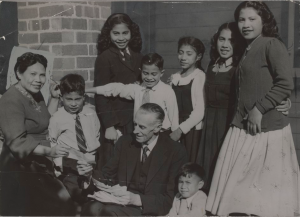The developments around the Netherlands East Indies (NEI) situation during the 1942-1945 period caused headaches for all parties involved, the interned and striking ‘Indonesians’, the Dutch and the Australians.
Under the White Australian policy, the non-European “Indonesians’ were – as agreed on their arrival in 1942 – not allowed to stay in Australia and with the war over most of them wanted to go home and the host country wanted to get rid of them ASAP. The ‘Indonesian’ prisoners who refused to work for the Dutch wanted to be returned to those parts of Indonesia under the control of the new republic and they were supported in this by the Australian Government, but the Dutch were vehemently opposed to this they wanted to bring them to those areas occupied by them. They were supported in this by the Brits and the Americans.
The chaos around repatriation led to further delays in their departure from Australia. Prisons and refugee centres were overflowing, other temporary facilities had to be used to house them such as the offices of the trade union in Brisbane and two empty hotels in Sydney.
The re-patriation process to Indonesia led to further Dutch-Australian conflicts, with Australian ships being intercepted by the Dutch and certain ‘Indonesians’ being removed from them forcibly and brought to Dutch prisons in areas in Indonesia controlled by them. However, in one way or another be it months or even a year later most of those who had been stranded or imprisoned in Australia or indeed re-occupied NEI did end up in the liberated areas.
The following story about Samuel Jacob has an interesting link to the White Australia policy, but apart from that there are other links to the broader story.
Returning from New Guinea to Cairns in September 1944, the C-47 (Dakota) DT-941 (VH-RDK) aircraft in which Samuel was flying disappeared without trace. It was not until 1989 that the remains of the aircraft and its 19 passengers and crew (including 14 Dutch airmen) were discovered in mountainous rainforest near Mossman, Queensland, about 150 kilometres short of their destination.
Samuel Jacob – Merauke, a plane crash and the ‘White Australia Policy’
|
Samuel Jacob, born in Ambon was a headmaster in Merauke, a job he combined with being a local civil administrator. Together with his family he was evacuated in August 1942 to Australia. Here he worked with the NEI government-in-exile for the re-building of Indonesia after the war. He worked here with van Mook and attended the school for civil servants that was established by van Mook in Melbourne. Samuel went back to Merauke in 1944 for a reconnaissance visit but on the way back his plane crashed near Mossman in Queensland. The wreck was not found until 1989. The 18 victims were buried with full military honours at the War Cemetery of Cairn on 28 July 1989.  The next angle to this story is that Samuel and his family while having the Dutch nationality, were all born in Ambon. Under the White Australian Policy, it had been negotiated with the Dutch Government that all ‘Indonesians’ (non-whites) would go back after the war. However, Samuel’s wife Annie and their seven children had settled in Melbourne and the kids were among the best pupils of their school and the family therefore wanted to stay in Australia. She had – after the death of her husband – married her landlord, John O’Keefe an Australian, however the Australian government wanted her and her family to leave. This became a political issue as the community around her as well as the national press got behind her, and eventually a High Court ruling allowed her to stay, this case became the first crack in the White Australian Policy, while over subsequent years watered down considerably it was only officially repealed in 1973. |